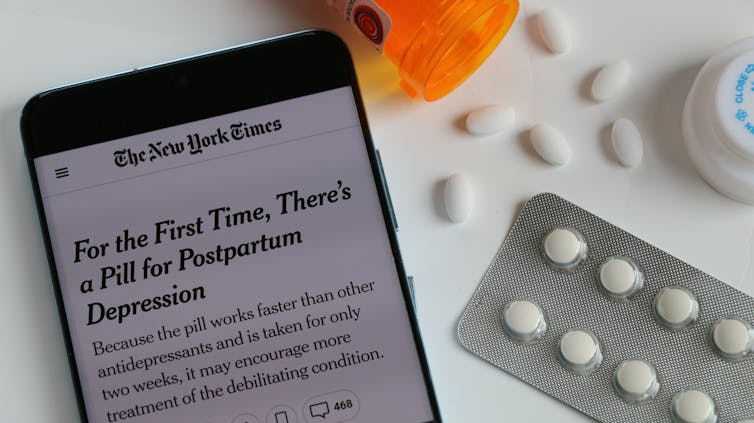Analysis: Zuranolone for postpartum depression: Hope, hype or both?

While zuranolone represents an exciting advance in the treatment of postpartum depression, many questions about its potential impact remain unanswered. (Shutterstock)
BY Ryan Van Lieshout
August 31, 2023
While mothers with postpartum depression have always faced barriers accessing the care they need, things have been particularly bad since the onset of the COVID-19 pandemic.
Prior to COVID-19, it was thought that up to one in five women would develop depression in the first postpartum year, but the stresses and service disruptions associated with the pandemic increased this to one in three. However, the pandemic also coincided with a period of significant innovation in treatment that may increase access to and effectiveness of care.
Talk therapy with other moms can effectively treat PPD, research shows
Medications specifically for PPD
One exciting development was the United States Food and Drug Administration’s approval of the medication brexanolone in early 2019. It represented the first of an entirely new class of medicines for postpardum depression (PPD), which target the steep decrease in hormones after delivery. Brexanolone is a synthetic version of allopregnanolone, a naturally occurring substance made from progesterone, that helps the brain regulate stress.
Its approval in the U.S. was especially notable for two reasons: it was the first medicine approved specifically for the treatment of PPD, and it takes effect especially quickly — within 60 hours.
While it represents a significant breakthrough, it must be given intravenously in hospital over 2½ days, and can cost as much as USD$34,000 per course.

On Aug. 4, the U.S. FDA approved zuranolone, another allopregnanolone derivative. Unlike brexanolone, zuranolone can be taken in pill form over two weeks, which is much shorter than traditional antidepressants which are usually prescribed for several months.
Early studies of zuranolone suggest PPD symptom improvement can be observed as early as three days after starting the treatment. This is an unusually rapid response to an antidepressant medication, which usually take effect over several weeks.
Behind the hype
The fanfare that has accompanied these medications also has the potential to increase awareness of PPD, suggesting a biological explanation for a condition associated with so much self-blame, encouraging more people to seek treatment and increasing screening and detection efforts among health-care providers.
If approved in Canada, it would also add to the array of effective treatments that already exist. These include evidence-based talking therapies like cognitive behavioural therapy and interpersonal psychotherapy, which are first-line treatments for mild to moderate PPD.
Antidepressant medications like the selective serotonin re-uptake inhibitors (SSRIS, such as sertraline and escitalopram) are also widely available and usually recommended as second-line therapies for most individuals with PPD.

Although psychotherapy and antidepressants can help most individuals with PPD, timely access to talking therapies is relatively rare within publicly funded health-care systems, and many prefer to avoid antidepressant medications during pregnancy and lactation if they can.
While zuranolone represents an exciting advance, many questions about its potential impact remain unanswered.
To date, just two clinical trials in humans exist, and eligibility for these studies was restricted to a very small subset of those with PPD. Only individuals with more severe depression that emerged between the third trimester of pregnancy and four weeks post-delivery could be enrolled.
Researchers also only studied zuranolone’s effects over six weeks, and no information on its safety during pregnancy and lactation is available (participants had to agree to stop breastfeeding while taking the medication).
Despite the excitement surrounding its U.S. approval, the cost of zuranolone is likely to be high, and it is not known if it will be approved in Canada. Finally, it is unclear if this medication will be covered by public or private insurers, which could put it out of reach for many with PPD who could need it the most.
PPD is still underdiagnosed
The development of innovative new medications is exciting and can generate significant hope for those affected. However, it is important in this case that we not lose sight of the fact that PPD is a vastly underdetected and undertreated problem for which safe and effective treatments already exist.

Free screening tools such as the Edinburgh Postnatal Depression Scale can be used to help detect PPD, and psychotherapy along with several existing antidepressants can be effective and safe during pregnancy and lactation.Inexpensive self-care interventions like improving social and practical supports, sleep hygiene, relaxation techniques, exercise and taking time for oneself can also be helpful, but can be challenging to engage in with a newborn.
Although provincially funded psychotherapy can be difficult to access, research and efforts to apply findings are starting to bring together the fragmented network of community organizations and traditional and public health services to try to increase access in Canada.
Research into treatments for PPD and the federal government’s actions in appointing a Minister of Mental Health and Addictions and prioritizing perinatal parents are also cause for genuine optimism.
While zuranolone is raising awareness about PPD, it’s important to highlight the need to develop national quality standards and Canadian-specific stepped-care models and care pathways. That would enable people to access existing treatments in a more timely manner, which would go a long way in helping Canada become the best country in the world to have a baby.
Ryan Van Lieshout, Canada Research Chair in Perinatal Mental Health, McMaster University. This article is republished from The Conversation under a Creative Commons license. Read the original article.


